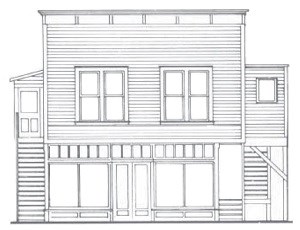
NPS photo 
NPS photo Building History
The first proprietor of this building was Henry Boas. Boas, a tailor and furrier, first moved to the neighboring gold rush town of Dyea in 1897, but with the collapse of that town, he moved to Skagway and purchased property on Broadway between Third and Fourth Avenues in 1899. Shortly thereafter, he erected this two-story false fronted building with the intention of attracting business. Shortly after the store opened, Boas formed a partnership with Charles R. Winter. Boas sold out to Winter in 1902 and left Skagway for the new gold rush boom towns of Fairbanks and Iditarod. Winter carried on with the business, advertising in the 1904 newspaper, "All Kinds of Goods at Eastern Prices, Coats, Capes, Boas, Muffs, Gloves, Robes, and Rugs of All Kinds. New Fur Mens Coats from $7.00 to $100.00. Genuine Seal Caps $7.00." Winter continued with the business, but apparently business proved to be unprofitable. Winter eventually sold his building to George B. Wright, a carpenter for the White Pass and Yukon Route Railway. For the next three years (1905-1908) several businesses operated in the structure. False Front Architecture
During Skagway's gold rush era, thousands of prospectors traveled through Skagway on their way to Dawson City and beyond. Most did not spend much time in Skagway, but many bought supplies or had services performed here before hurrying up the White Pass Trail or, later, boarding a railcar on the White Pass &Yukon Route Railway. To grab the attention of these customers and the contents of their wallets, many businesses erected elaborate false fronts on their buildings. These false fronts projected an image of size and prosperity. Customers were more apt to buy from a solid, stable company than from one which was not, even if that stability was in looks only. False front architecture is characterized by an elaborate wall added to the front of a usually simple gable-roofed building. Compared to the front of the structure, the building's sides and back were often less substantially constructed. A look at the Boas building's roofline from the side will reveal its false front. 
Advertisement from the Daily Alaskan, October 1, 1910 Later Building History The building's use continued to change, however. In the 1930s, the Canadian National Steamship Company and the Admiral Line leased the space for their offices. During World War II, Army draftsmen prepared plans for the Alaska-Canada Highway project in the building. After World War II, the building was once again used as a curio shop. In 1978, Jack Kirmse, the son of Herman Kirmse, sold the building to the National Park Service. The National Park Service restored the structure in 1986 and the building is currently part of the park's historic property leasing program. Today, the restored Boas Tailor and Furrier stands as a reminder of Skagway as a boom town, both in its frontier past and its modern present. Historic Building Leasing Program Learn More!
|
Last updated: December 9, 2019
